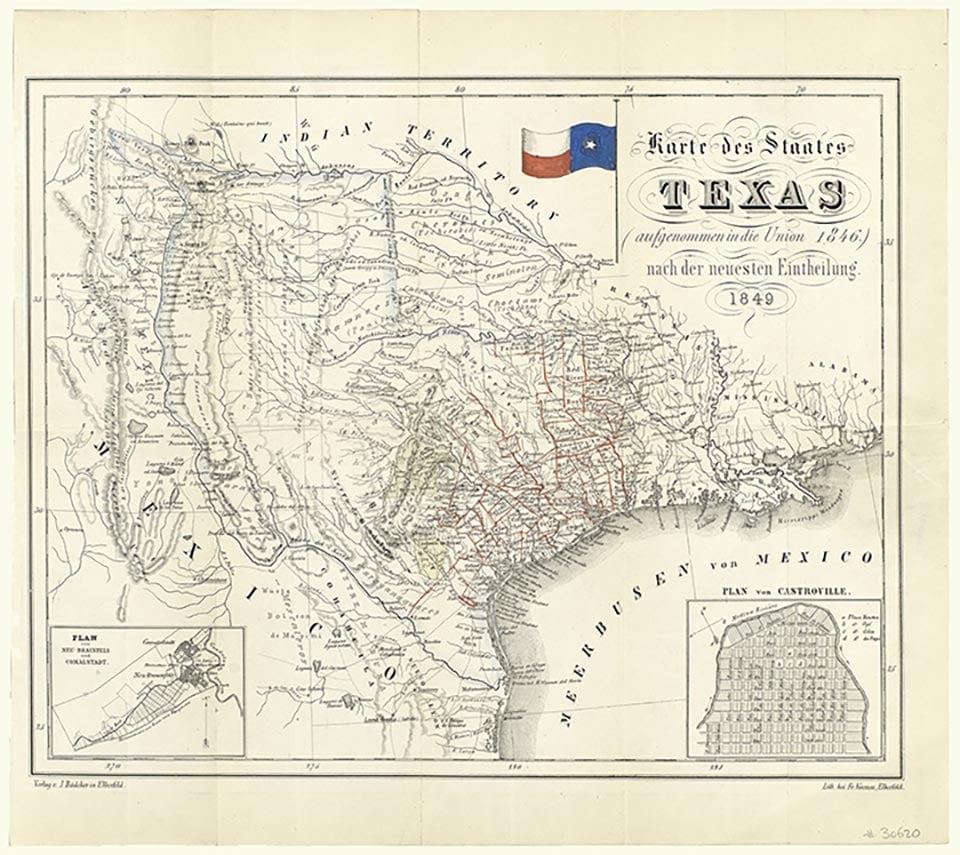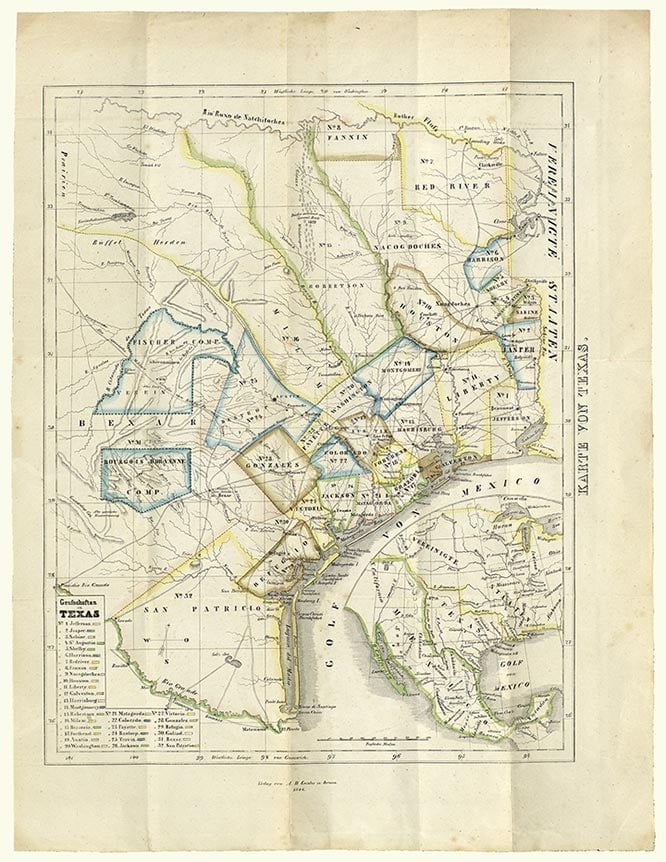Bastrop, county seat of Bastrop County, is located in the center of the county, about thirty miles southeast of downtown Austin. The town is at the junction of State highways 71, 21, and 95, and on the Colorado River and the Missouri, Kansas and Texas Railroad. The site was first occupied in 1804, when a fort was established at the strategic Colorado River crossing of the Old San Antonio Road and named Puesta del Colorado. The Baron de Bastrop obtained permission from the Spanish to found a German colony and selected the site in 1823, but subsequently failed to establish a settlement. The town was probably named Bastrop by Stephen F. Austin in honor of the baron, a longtime friend and coworker. Austin, interested in developing the upper reaches of his original colony, used this name after the German colonization attempt failed and he obtained permission in 1827 to locate a "Little Colony" of 100 families on the site. He had seen the future townsite on his first journey to Texas, and had noted it favorably in his journal. By 1830 such pioneers as Josiah Wilbarger, Reuben Hornsby, James Burleson, Edward Burleson, and Jess Barker had located in the Bastrop area. But the Indian depredations that had doomed the German colonization attempt continued to slow settlement. In 1830 a traveler wrote that the population of Bastrop consisted of a bachelor and two families, with John F. Webber and the Wilbarger family living a short distance to the north.
On June 8, 1832, land commissioner José Miguel de Arciniega officially platted the town along conventional Mexican lines, with a square in the center and blocks set aside for public buildings. He also officially named the site Bastrop, but two years later the Coahuila and Texas legislature renamed it Mina (see MINA MUNICIPALITY), in honor of Francisco Xavier Mina, a Mexican martyr and hero.
On January 1, 1835, Juan N. Almonte reported a population of 1,100 in the area, and at the outbreak of the Texas Revolution the town's population was approximately 400. Bastrop served as a business, commercial, and political center for an area that stretched far beyond Bastrop County; it was the place where settlers rallied for retaliation and forted up for protection when Indian depredations occurred in the vicinity. Until the railroad reached the county in the early 1870s, Bastrop was the only town in the county. In May 1835, Mina citizens became the first to organize a committee of safety to stockpile arms and keep citizens informed of revolutionary developments. The town suffered in the Runaway Scrape of 1836, when residents returned to find it completely destroyed by the Mexican army and Indians. Indians, particularly the Comanches, who hunted in the area every fall, continued to provide a major threat until after annexation to the United States in 1846.
The town was incorporated under the laws of Texas on December 18, 1837, and the name changed back to Bastrop. The community then comprised a courthouse, a hotel, a stockade, a gunsmith shop, a general store, and a number of residences. With farming, the timber industry provided a mainstay for the local economy from 1836 to 1860. The Lost Pine Forest, the westernmost stand of the eastern pine forest and the only timber available in what was then western Texas, contributed to the economy. In 1839, when Austin became the capital of the republic, Bastrop began supplying the city with lumber. Soon, ox teams were carting Bastrop lumber to San Antonio, along the western frontier, and into Mexico.
Though Protestant services were held in Bastrop as early as 1835, official organization of a Protestant congregation did not occur until three years later, when a Methodist church with fifteen members was begun. The introduction of slaves to the area helped make cotton a major part of the local economy after 1839 and lessened the priority of lumber. A post office was established in 1846, and a one-room log school was in operation the next year. By the 1850s Bastrop was developing rapidly. In 1851 Bastrop Methodists built the county's first church, a weekly newspaper was founded, and the Bastrop Educational Society opened Bastrop Academy. By the following year, the Bastrop Advertiser had begun its long publishing history, the academy had been incorporated as Bastrop Female Academy, and a subscription library had begun. In 1856 Bastrop Military Institute (later Texas Military Institute, Austin) opened.
Although Bastrop County residents voted against secession by a narrow margin, the citizens of Bastrop aided the Confederate cause in a number of ways, including raising money to equip companies and providing a supply warehouse. Fire destroyed most of the downtown buildings in 1862, but flood posed an even greater threat. A flood of area creeks in 1869 forced evacuation of the town as waters rose as high as forty-six feet. Periodic inundations continued to plague the area until dams were built in the 1930s. Despite natural disasters, the period during and after the Civil War saw the rise of varied industry in Bastrop. Through the 1860s and 1870s such businesses as the Bastrop Iron Manufacturing Company, the Bastrop Coal Company, and Lone Star Mills got their start. By 1884 Bastrop had a population of 2,000 and three schools, two cotton gins, several general stores, and a number of other businesses. A wrought-iron bridge erected across the Colorado in 1890 put the ferries out of business.
With the turn of the century, stock raising increased. Bastrop established a public library, and by 1909 had graded schools and two banks. The population in 1910 was 1,707. It hovered around the 2,000 mark through the early twentieth century. In the 1920s the Bastrop area was the scene of oil drilling, and between 1928 and 1935 lumber operations were revived; a Bastrop mill produced thirty million board feet of lumber annually during those years. Although coal was known to exist in large quantities a few miles from Bastrop as early as 1837, and was mined between 1860 and 1870, major lignite extraction began only around 1910 and from then until 1940 was the community's predominant industry.
The population peaked at about 5,000 during World War II, after the establishment of nearby Camp Swift. When the camp gradually closed after the war, Bastrop shrank to 4,000, then 3,158 in 1950. Industries in 1947 included a pecan-shelling plant, a cedar-chest factory, and a cedar-oil manufacturer. From 1950 through the 1970s Bastrop's population ranged between 2,950 and 4,050. The 1980s brought new challenges for the community as Austin grew eastward, Austin sewage polluted the Colorado, and strip-mining began pressing from the east. The town's population was 4,044 in 1990 and 5,340 in 2000. Residents had restored many historic buildings, and commuters from Austin lived in Bastrop. As a consequence of the town's proximity to Austin, land values soared. Bastrop remained a center for agribusiness. Its industries included oil-well supply and furniture manufacturing.







